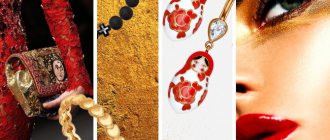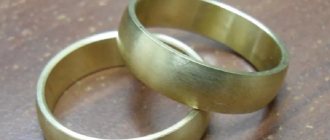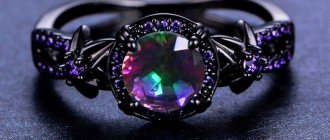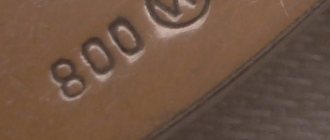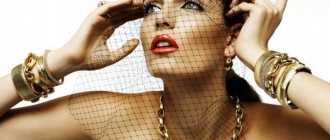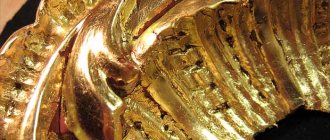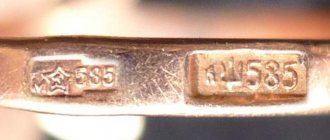Gilding of metal is a popular procedure that allows you to give various products the properties that a noble metal has. Applying a gold plating allows you to get an excellent item at significantly lower costs than when buying real jewelry. In addition, the technology of electroplating with gold eliminates the oxidation of metals; the surface layer is not afraid of moisture and does not react with chemically active substances. Gold plating also improves the quality of solder, which is important in the manufacture of microcircuits.
Solutions for gilding
To apply a layer of gold to an object, it must be dissolved. Gold is a metal that is chemically inert, which is why it is valued, and that is why it is not so easy to do. The only solvent for gold can be aqua regia, a chemical substance that is a mixture of nitric and hydrochloric acids. You need to take three volume parts of hydrochloric acid, and one volume of nitric acid.
Gold plated ring
After the gold has dissolved, the liquid must be evaporated. You just need to do this carefully, outdoors, following the rules of caution, using a respirator and gloves. Gases that evaporate during evaporation should absolutely not be inhaled, otherwise you may get a burn to the mucous membrane. It is also necessary to use goggles to protect your eyes. After the liquid evaporates, gold chloride remains.
Kinds
The most common type is still gilding. Also in recent years, gold leaf gilding has become popular among decorators, which is much more accessible and cheaper.
Gold leaf
Gold leaf is 960-carat metal, rolled out to a thin sheet. In Rus', gold leaf was traditionally used to cover the domes of churches. In Russia it is sold in the form of books of 60 sheets with an area of 10 cm2 each.
The thickness is not regulated, but the most popular sheets are 10 times thinner than a human hair. It is used to decorate objects of art and for interior design. For outdoor decoration (fountains, domes, sculptures) thicker sheets are used.
Potal
Potal is a replacement for the usual gold leaf. It appears as gold sheets or strips and is an alloy of copper and zinc or aluminum. There is a potal imitating gold, silver and bronze. A drawing can be applied to the sheets. You can find gold leaf on sale in the form of multi-colored crumbs.
What are their differences?
The main difference between gold and gold is that it does not contain precious metal. This naturally affects its price: gold leaf is much cheaper. Without a protective coating, it may fade over time.
Gilding methods
To gild an item using the rubbing method with gold chloride, the latter must be dissolved in potassium cyanide, then mixed with washed chalk until it becomes mushy. The object is coated with this solution, after which it is waited for some time, washed and polished.
If it is necessary to coat steel or iron with such a layer, gold chloride is dissolved in ether. The solution is applied to the surface, and after the ether has evaporated, rubbed with a rag. If you do this not with a brush, but with a quill pen, you can get a pattern.
Zinc is coated as follows. Prepare a paste that consists of 60 g of potassium cyanide and 20 g of gold chloride, dilute them in 100 g of water and shake. Then filter and add a mixture of tartar and chalk, 5 g and 100 g, respectively, until the consistency of gruel. The paste is applied to the metal with a brush or brush.
Gilding of silver is done in a slightly different way. Gold is dissolved in aqua regia diluted with water, after which potash is added and poured into an iron cauldron, where two liters of water are already boiling. This liquid is boiled for 120 minutes.
Silver objects that want to be gilded are calcined and etched with a solution of sulfuric acid. After this, they are placed in nitric acid for a short period of time. Then they are tied with brass wire and quickly sent into a liquid, which is a mixture of three acids - nitric, sulfuric and hydrochloric, and removed immediately. Then the products are rinsed with water, immersed in mercury and water, and after half a minute in a bath of liquid, which consists of 10 g of gold, 25 g of nitric and hydrochloric acids, 25 g of water and 300 g of potash.
After gilding, the products are washed and dried in sawdust. If, while the products are immersed in a bath of gilding solution, you touch them with a zinc stick, then the gold layer will be larger.
If contact with zinc is necessary, use the following solution:
- 15 g gold chloride;
- 65 g potash;
- 65 g of potassium ferrous sulfide, or yellow blood salt;
- 2 liters of water.
In order to coat products with such a solution, cleaned and degreased objects are placed in a heated solution and a zinc stick is used for contact.
If it is necessary to coat copper or its alloys with gold, then 10 g of sodium phosphorus salt and 6 g of potassium hydroxide are dissolved in 1.5 liters of water. Separately, 2 g of gold chloride and 32 g of potassium cyanide are dissolved in 0.5 liters of water and the solutions are mixed. When gilding, the mixture will need to be brought to a boil.
To gild iron, steel, zinc or tin in this way, they are first coated with a layer of copper.
If it is necessary to coat metal wire, it must first be placed in a solution of one part sulfuric acid to 10 parts water. After this, it is soaked in nitric acid and dipped into a copper solution. Next, prepare solutions for gilding: 150 g of potassium per 5 liters of water and 10 g of gold chloride in one container and 50 g of sodium hydrogen phosphate per 5 liters of water and 50 g of potassium hydroxide. The solutions are mixed and brought to a boil, after which a copper-impregnated wire is lowered into it.
Where is it used?
Today, gold plating is used in the following areas:
- jewelry making;
- art (in sculpture; in painting, gilding is used not only on frames, but also directly on paintings);
- Interior design;
- automotive industry (for decorative purposes);
- dentistry;
- electronics (gold is an excellent conductor);
- cosmetology.
The last area of application is the most controversial. Most often, the use of gold in cosmetology is just a cunning marketing ploy. Nevertheless, in Japan they are working on the latest technique of gilding the face. It is believed that this metal enriches the skin with oxygen, preserves collagen and helps relieve irritation.
There is even a separate direction in alternative medicine - chrysotherapy, in which gold is used to treat inflammation. From a scientific point of view, such properties of the metal have not been proven, since a full-scale study of the effect of gold on the human body has never been carried out. But the placebo effect cannot be ignored.
Gilding by electroplating
To gild a product using this method, you will need:
- 60 g sodium hydrogen phosphate;
- 1 liter of water;
- 3 g gold chloride;
- 1 g potassium cyanide;
- 10 g sodium disulfate.
Sodium hydrogen phosphate is mixed with water at room temperature (0.7 l) and kept in it until completely dissolved. In another container, 2.5 g of gold chloride is dissolved in 150 ml of water. After this, another 1 g of potassium cyanide and 10 g of sodium disulfate are dissolved in 150 ml of water. The first two masses are mixed together, after which the third is added. A platinum cathode is used for gilding. When the solution is depleted, more gold chloride is added.
Electroplating gold plating
Gilding of metals: silver, iron, copper and others is carried out with the preliminary application of another metal; without a gasket, it is done using a Zelmi bath. To do this, take 1 g of soda ash and bring it to a boil in a porcelain cup with the same amount of potassium ferric sulfide and 30 g of water. Next, add gold, which was obtained by precipitation with ammonia, 50 g of gold chloride and boil for 12 minutes. After this time, a red precipitate should form and the liquid should take on a golden color. After this, it is filtered and used for electroplating.
It is not difficult to coat metals with gold; the reagents for this are quite affordable. This may well become relevant if you want to regularly coat large volumes of products with noble metal or open your own workshop.
What is gilding
Gold plating is a thin layer of gold that can hide almost any material. Its thickness can be from 1 to 20-25 microns, and the object becomes practically indistinguishable from gold. The method is used not only in jewelry, but also in architecture, design and even cosmetology.
Brief history of appearance
The art of gilding luxury items first appeared several thousand years ago in Ancient Egypt. It was he who became the first country in which gold mining took on an industrial scale. Since all the mines belonged to the pharaoh, it is not surprising that household items of the ruling family were the first to be gilded.
There is an alternative version that claims that the practice of gold plating originated in China. However, a simple comparison of historical facts speaks in favor of Egypt. The gold-plated sarcophagi of the Egyptian pharaohs date back more than 5,000 years, while in Lao Tang (the province of China considered the birthplace of gilding), thin gold plates have only been produced for about 2 millennia.
The art of gilding, having passed through the Middle East and reached Ancient Rus', received a significant impetus for development and reached a completely new level. It was in Rus' that gold became not just a sign of status and luxury, but also a symbol of faith and divine light.
Expert opinion
Vsevolod Kozlovsky
6 years in jewelry making. Knows everything about samples and can identify a fake in 12 seconds
The popularity of gilding, so beloved by Russian people, led to the creation of an original school, the development of its own methods and secrets. Gilding masters took boys from a very early age to teach them all the subtleties of their profession. And only a few of them actually reached the heights of mastery.
The next step in the development of art is the merit of architects, primarily Bartolomeo Rastrelli. It was he who brought into fashion the Baroque style, which is characterized by gilding not only furniture, but also stucco.
Discovery of the galvanic method by B.S. Jacobi made gilding jewelry safer and easier in the 19th century. Electroplating has taken the technique of applying gold plating to a new level.
Another idea for the holiday
Using glue, draw an outline on a sheet of gift paper and leave it to dry until the glue becomes transparent. Then we put gold or silver transfer foil on top and gently rub it in. After this, carefully remove the base paper. This design can even be made on textiles - a T-shirt or baseball cap. A great gift for the New Year - both unique and practical!
A great idea for decorating gift boxes for Christmas or New Year | |
Difference between gold and gilding
The main difference is in the composition. Even a professional cannot always distinguish them by their appearance. Gold jewelry is durable, since the layer does not wear off, and is often much more expensive. Due to their short service life, gold-plated items are not worn every day and require more careful care.
With the development of technology, new methods of gilding have appeared. They allow you to achieve a thicker coating. Such bracelets and rings last much longer, but their price is higher than regular gold plated ones.
Care, cleaning and storage of gold-plated items
In order for your jewelry to last as long as possible, you must follow a few simple rules for caring for gold plating.
| Wearing | Be sure to remove gold-plated jewelry before any contact with water (shower, swimming pool, washing dishes) or sports activities. Avoid contact with cosmetics. Don't forget that everyday wear shortens their service life. |
| Storage | Store only in a separate box or fabric bags so as not to damage the layer with other decorations. |
| Cleaning | Clean only with a soft cloth without using abrasives. If dark spots just appear, just wipe with ordinary vinegar and rinse in water. The shine will help return the egg white (after it you will also need to rinse in clean water). Once a year, items should be taken to a jeweler for professional cleaning. |
Despite the fact that sooner or later the coating wears off, it can always be renewed in a jeweler’s workshop.
Gold color technologies
The gilding technique changed, improved and was divided into two main methods of application: clay and Mordan glue.
- Antique clay gilding: multi-layer surface preparation using a complex primer, polyment for the application of gold leaf itself for relief. This method is suitable for processing wooden coverings indoors, clay-based products, and icons. Today there are special mixtures, ready for use, which are easy to buy in St. Petersburg, Moscow and other regions of the country.
- Popular gilding on glue: the gold layer is applied to a special oil varnish-mordan. Advantages of the method: simplicity, accessibility, moisture resistance. This technique is used by craftsmen more often and on various surfaces: metal, wood, plaster, mastic, stone.
How to spot a fake
According to statistics, 4 out of 10 gold jewelry is fake. Unfortunately, you can buy gilding for the price of full gold even in a jewelry store. There is only one method of checking that would allow you to avoid counterfeiting at the purchase stage - make a transaction in large, trusted jewelry stores and be very attentive to the product itself.
Signs that jewelry is fake:
- Uneven color. Gold plating can wear off in places even with careful storage and transportation. Moreover, the fakes use a very thin layer.
- Some “experts” on the Internet advise checking with a magnet. Gold should not be magnetic. However, given that many metals do not react to magnets, this method is practically useless.
- Very often, scammers remove the stamped lock from real gold jewelry and attach it to gold plated jewelry. Therefore, one way to identify a fake is to carefully examine the links next to the lock. Any defects in this area may indicate that this is a fake.
At home, if the product has already been purchased, it is much easier to check:
- Chemical method. You can purchase a special set of reagents for testing. This method is suitable for those who often buy gold and not always in reliable places.
- You can drop alcohol onto the surface: low-quality gold will darken.
- If in search of the truth you don’t mind spoiling the appearance of the jewelry, then you can scratch the surface. Small particles will fall off the gilding, leaving noticeable damage.
The most reliable way to check is always a consultation with a specialist. For a small fee, any pawn shop will conduct a series of tests and samples to ensure authenticity.
What metals can be gilded
Jewelers quite often use gold plating for silver items. Bronze, copper, cast iron, brass, aluminum, galvanized iron and other well-known metals can also be coated with gold. Certain industries practice gilding of wooden, clay, plastic, and plaster objects. A gold layer can be added to ceramics and cardboard.
Gilding decoration
Surface preparation
Before you start painting the surface, you need to prepare it:
1. Clean off dirt with a sponge and soap solution so that the paint lays evenly and does not create bumps.
2. Be sure to degrease the surface using a special product and dry it.
3. Roughen the coating using fine-grained sandpaper for uniform application and good adhesion of the paint to the surface.
4. Use masking tape to seal those areas that should not be painted.
